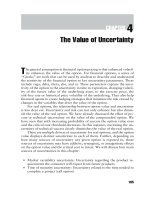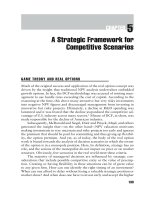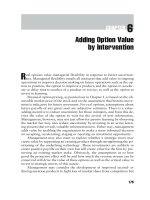Lecture Project management in practice - Chapter 1: Modern project management
Bạn đang xem bản rút gọn của tài liệu. Xem và tải ngay bản đầy đủ của tài liệu tại đây (260.48 KB, 17 trang )
CHAPTER 1
Modern Project
Management
Copyright © 2013 McGraw-Hill Education (Australia) Pty Ltd
Pearson, Larson, Gray, Project Management in Practice, 1e
1-1
Learning Elements
1.1 Understand how projects differ from routine
operational work.
1.2 Develop an understanding of the background
to project management.
1.3 Understand at a broad level the concept of a
project life cycle.
1.4 Make the link between an organisation’s
strategy and the need for projects.
Copyright © 2013 McGraw-Hill Education (Australia) Pty Ltd
Pearson, Larson, Gray, Project Management in Practice, 1e
1-2
What is a Project?
Characteristics
• An established objective
• A defined lifespan with a defined beginning
and end (temporary)
• Usually the involvement of several
departments and/or professionals
• Typically doing something that has never
been done before (unique)
• Specific time, cost and performance
requirements
Copyright © 2013 McGraw-Hill Education (Australia) Pty Ltd
Pearson, Larson, Gray, Project Management in Practice, 1e
1-3
What is not a Project?
• Routine, repetitive work
• Ordinary daily work that typically
requires doing the same, or similar work,
over and over
Copyright © 2013 McGraw-Hill Education (Australia) Pty Ltd
Pearson, Larson, Gray, Project Management in Practice, 1e
1-4
Comparison of Routine Work and Projects
Routine, repetitive work
Projects
• Taking meeting notes
• Daily entering sales
receipts into the
accounting ledger
• Responding to a supplychain request
• Practising scales on the
piano
• Routine manufacture of
an Apple iPod
• Writing a book.
• Setting up a sales kiosk
for a professional
accounting conference
• Developing a supplychain information
system
• Writing a new piano
piece
• Designing a new media
player
Copyright © 2013 McGraw-Hill Education (Australia) Pty Ltd
Pearson, Larson, Gray, Project Management in Practice, 1e
1-5
Program versus Project
• A program is the application of knowledge,
skills, tools and techniques to meet specific
requirements.
• A program obtains benefits and control not
available by managing projects individually.
Copyright © 2013 McGraw-Hill Education (Australia) Pty Ltd
Pearson, Larson, Gray, Project Management in Practice, 1e
1-6
Portfolio versus Program
• Portfolios provide an overarching
umbrella for an organisation to manage
all investment activity.
• Portfolios may be managed as a mix of
programs and/or major projects.
Copyright © 2013 McGraw-Hill Education (Australia) Pty Ltd
Pearson, Larson, Gray, Project Management in Practice, 1e
1-7
The Project Life Cycle
Copyright © 2013 McGraw-Hill Education (Australia) Pty Ltd
Pearson, Larson, Gray, Project Management in Practice, 1e
1-8
The Project Manager
• Marshals resources for the project and relates
directly to the customer
• Provides direction, coordination and integration to
the project team
• Is responsible for the performance and success of
the project
• Must induce the right people at the right time to
address issues, make decisions and carry out the
project’s activities
• Addresses the right issues and makes the right
decisions
Copyright © 2013 McGraw-Hill Education (Australia) Pty Ltd
Pearson, Larson, Gray, Project Management in Practice, 1e
1-9
The Importance of Project
Management
• Compression of the product life cycle
• Complexity
• Triple bottom line (planet, people, profit)
• Corporate downsizing
• Increased customer focus
• Organisational change management
• Small projects represent big problems
Copyright © 2013 McGraw-Hill Education (Australia) Pty Ltd
Pearson, Larson, Gray, Project Management in Practice, 1e
1-10
Project Management Today:
A Holistic Approach
Integrative approach
• The big picture: how organisational resources are
being used
• An assessment of the risk to their portfolio of
projects
• A rough metric for measuring the improvement of
managing projects relative to others in the industry
• Linkages to senior management
• Performance management of projects
• A clear definition of benefits
Copyright © 2013 McGraw-Hill Education (Australia) Pty Ltd
Pearson, Larson, Gray, Project Management in Practice, 1e
1-11
Alignment of Projects with
Organisational Strategy
Copyright © 2013 McGraw-Hill Education (Australia) Pty Ltd
Pearson, Larson, Gray, Project Management in Practice, 1e
1-12
Project Management Today:
A Holistic Approach (cont.)
Includes:
• Project selection
• Monitoring aggregate resource levels and skills
• Use of best practices
• Balancing projects in a portfolio
• Improving communication among all stakeholders
• An organisational perspective, beyond silo thinking
• Improving management of projects over time
Copyright © 2013 McGraw-Hill Education (Australia) Pty Ltd
Pearson, Larson, Gray, Project Management in Practice, 1e
1-13
The Technical and Socio-cultural
Dimensions of the Project
Management Process
Copyright © 2013 McGraw-Hill Education (Australia) Pty Ltd
Pearson, Larson, Gray, Project Management in Practice, 1e
1-14
Common Pitfalls in Project
Management
•
•
•
•
•
Not being aligned to organisational strategy
Lack of top management or sponsor support
Political discord or disagreement
Poor or inadequate estimating
Working backwards from a given drop-dead
date
• Inexperienced project management personnel
• Fragmented team and team values
Copyright © 2013 McGraw-Hill Education (Australia) Pty Ltd
Pearson, Larson, Gray, Project Management in Practice, 1e
1-15
Common Pitfalls in Project
Management (cont.)
•Poorly/vaguely defined requirements (Scope)
•Lack of user (customer) involvement
•Unrealistic requirements or expectations
•Scope creep
•Poor communication or lack of communication
•Ignoring project warning signs
•Poor governance
Copyright © 2013 McGraw-Hill Education (Australia) Pty Ltd
Pearson, Larson, Gray, Project Management in Practice, 1e
1-16
Key Terms
roject
rogram
ortfolio
roject life cycle
trategic alignment
ocio-technical perspective
ommon pitfalls
Copyright © 2013 McGraw-Hill Education (Australia) Pty Ltd
Pearson, Larson, Gray, Project Management in Practice, 1e
1-17









